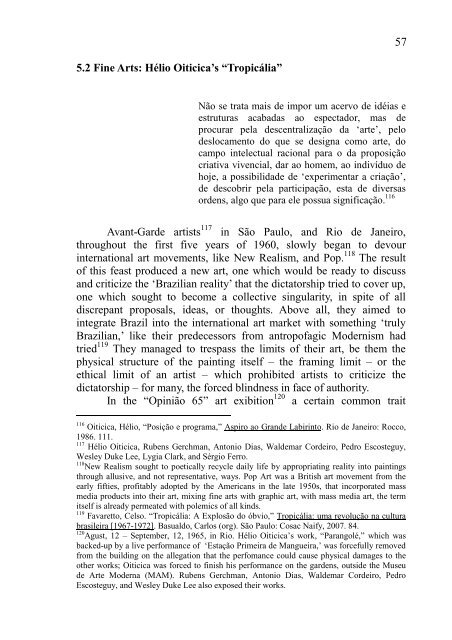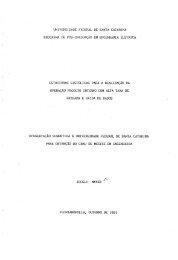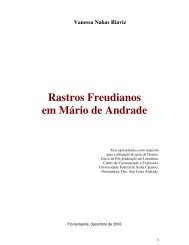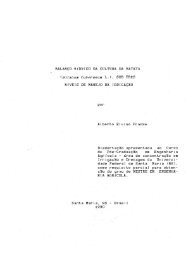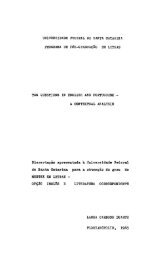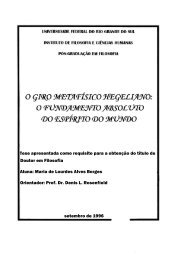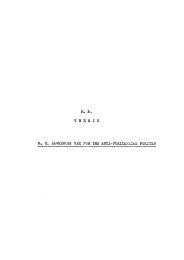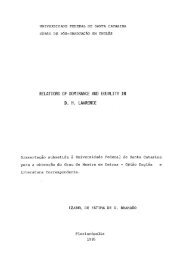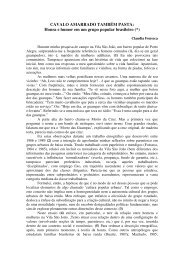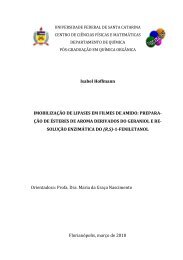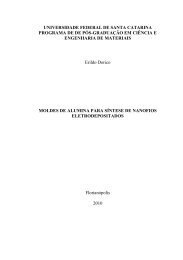Tropical ginsberg
Tropical ginsberg
Tropical ginsberg
You also want an ePaper? Increase the reach of your titles
YUMPU automatically turns print PDFs into web optimized ePapers that Google loves.
5.2 Fine Arts: Hélio Oiticica’s “Tropicália”<br />
57<br />
Não se trata mais de impor um acervo de idéias e<br />
estruturas acabadas ao espectador, mas de<br />
procurar pela descentralização da ‘arte’, pelo<br />
deslocamento do que se designa como arte, do<br />
campo intelectual racional para o da proposição<br />
criativa vivencial, dar ao homem, ao indivíduo de<br />
hoje, a possibilidade de ‘experimentar a criação’,<br />
de descobrir pela participação, esta de diversas<br />
ordens, algo que para ele possua significação. 116<br />
Avant-Garde artists 117 in São Paulo, and Rio de Janeiro,<br />
throughout the first five years of 1960, slowly began to devour<br />
international art movements, like New Realism, and Pop. 118 The result<br />
of this feast produced a new art, one which would be ready to discuss<br />
and criticize the ‘Brazilian reality’ that the dictatorship tried to cover up,<br />
one which sought to become a collective singularity, in spite of all<br />
discrepant proposals, ideas, or thoughts. Above all, they aimed to<br />
integrate Brazil into the international art market with something ‘truly<br />
Brazilian,’ like their predecessors from antropofagic Modernism had<br />
tried 119 They managed to trespass the limits of their art, be them the<br />
physical structure of the painting itself – the framing limit – or the<br />
ethical limit of an artist – which prohibited artists to criticize the<br />
dictatorship – for many, the forced blindness in face of authority.<br />
In the “Opinião 65” art exibition 120 a certain common trait<br />
116<br />
Oiticica, Hélio, “Posição e programa,” Aspiro ao Grande Labirinto. Rio de Janeiro: Rocco,<br />
1986. 111.<br />
117<br />
Hélio Oiticica, Rubens Gerchman, Antonio Dias, Waldemar Cordeiro, Pedro Escosteguy,<br />
Wesley Duke Lee, Lygia Clark, and Sérgio Ferro.<br />
118<br />
New Realism sought to poetically recycle daily life by appropriating reality into paintings<br />
through allusive, and not representative, ways. Pop Art was a British art movement from the<br />
early fifties, profitably adopted by the Americans in the late 1950s, that incorporated mass<br />
media products into their art, mixing fine arts with graphic art, with mass media art, the term<br />
itself is already permeated with polemics of all kinds.<br />
119<br />
Favaretto, Celso. “Tropicália: A Explosão do óbvio,” Tropicália: uma revolução na cultura<br />
brasileira [1967-1972]. Basualdo, Carlos (org). São Paulo: Cosac Naify, 2007. 84.<br />
120<br />
Agust, 12 – September, 12, 1965, in Rio. Hélio Oiticica’s work, “Parangolé,” which was<br />
backed-up by a live performance of ‘Estação Primeira de Mangueira,’ was forcefully removed<br />
from the building on the allegation that the perfomance could cause physical damages to the<br />
other works; Oiticica was forced to finish his performance on the gardens, outside the Museu<br />
de Arte Moderna (MAM). Rubens Gerchman, Antonio Dias, Waldemar Cordeiro, Pedro<br />
Escosteguy, and Wesley Duke Lee also exposed their works.


